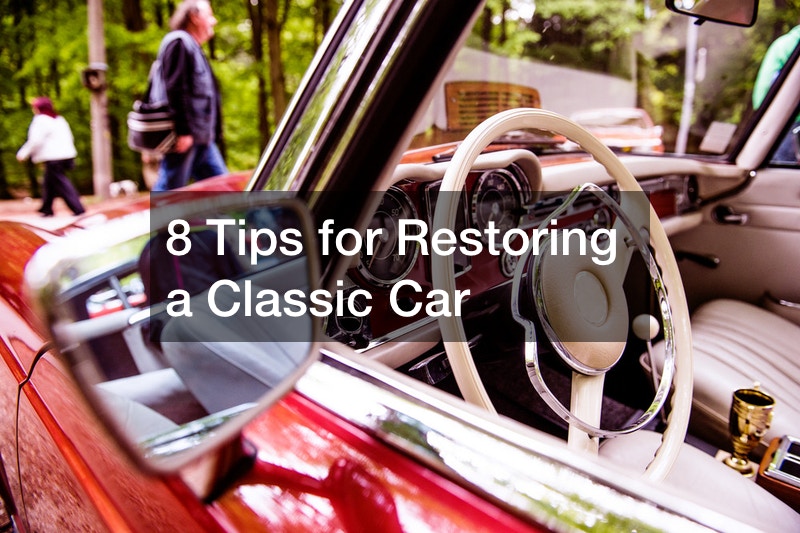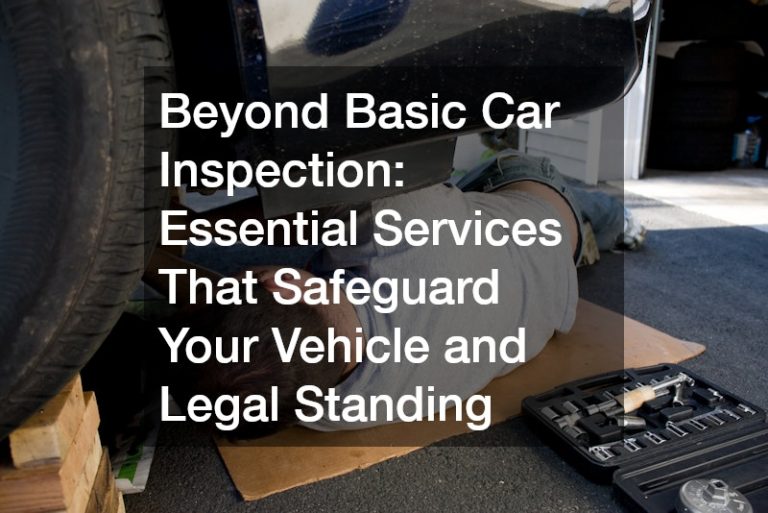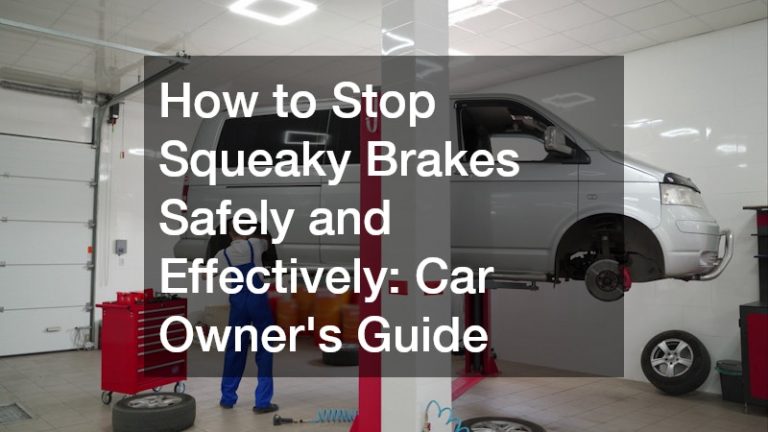

Whether you are thinking of restoring a vehicle to its original state or incorporating your personality and flair into the mix, you need to know the steps to take for a successful project. Restoration requires patience, time, a workshop, skill, and love, making it a rewarding experience when done right. The process also enables classic car enthusiasts to possess their dream car without breaking the bank to purchase the rare original classic cars.
Learning the steps to take and correctly implementing them is the key to breathing new life into your favorite classic vehicle. Here are 8 tips you can study to make it easy to restore classic cars:
1. Work within Your Ability
You want to take the time to learn about restoration techniques and tools through knowledgeable friends or classes. The thorough research means you will have a longer timeline for restoring your car. Nonetheless, the finished project will outlast your stewardship of it and offer a far more rewarding result.
When looking at a car restoration project, the last thing you want is to work beyond your means since you will most likely rush through the process to compensate for your shortcomings. As Rob Hill once said, ‘ rushing things ruin things,’ and the same quote applies in this case. For instance, metalwork is a vital aspect of classic car restoration, and poor performance on it will lead to rust and unappealing traces, damaging the outcome.
Another aspect to keep in mind is setting goals. You want to set monthly, weekly, and daily targets, helping you make each day count. In addition, you can adjust the schedule to accommodate comfortable tasks during smaller windows of work opportunities. This management allows you to navigate complicated and easy tasks with ease without the risk of frustration and getting overwhelmed.
It is generally advisable to overestimate how long each task will take, enabling you to keep in check your expectations. Building your expectations is critical since it allows you to enjoy the restoration process.
2. Invest in Your Project

Someone said that time is what we want most but what we use worst. Proper time management is the key that will make it easy to restore classic cars. Your project is sure to fail from the off if you do not have enough time on your hands. Stalling the project for too long can also take the enjoyment out of the experience, leaving you frustrated and tempted to give up halfway. Ideally, you want to focus fully on the restoration without compromising your work or family life.
Besides time, you want to prepare your budget and find a vehicle that will match your planned expenditure. You should avoid the temptation of identifying a car that you love and budgeting around it. In doing so, you risk falling into debt and stopping your project midway due to a lack of adequate funds to purchase additional restoration parts.
You want to consider the cost of purchasing the classic car, materials, and tools. It is essential to incorporate all project elements into your calculations to ensure you do not run short. If you require professional assistance to undertake certain tasks, you also need to include the fees in your budget.
When looking to undertake the project on a budget, you can search for more affordable replacement parts. For example, you can visit vehicle salvage centers in your region to see if they possess a similar car and the components available. You can also look at online car collector groups and sellers to identify people offering spares of your vehicle’s make.
3. Identify the Right Car
Identifying the right make and model you love ensures you can find it easy to restore classic cars. You can start by talking to classic car enthusiasts, checking online advertisements, and reading automobile magazines. These sources can help you identify a potential project that can suit your interest and preference.
When looking for the right fit for your needs, you need to keep in mind the following factors to make the appropriate selection:
Survey Your Options
It is critical to remember not to hurry when making a choice. Visit different locations offering used cars for sale and look at the different classic cars available. Although it is common for people to fall in love with the first car they see, you want to keep on surveying since you will likely find a better option down the line.
Depending on your desired working timeline, you can choose a partially restored vehicle that someone could not finish. Additionally, you want to study and learn about your ideal vehicle’s production history. This knowledge enables you to understand better what standard equipment parts may be missing during your survey. You also need to inspect the undercarriage carefully to spot potential rust damage in hidden areas such as underneath carpets or within a frame rail.
After the inspection, you can then prepare a list of known problem areas that you have to address. This preparation aids in your managing your plans, since you can commence a preliminary search for replacement components. You can know whether you will obtain reproductions, new old stock, or used parts, allowing you to add their costs into your planning.
Besides these, you want to know what a good price is by researching the high, average, and low retail prices. Most people, unfortunately, fall into fraud since many buyers provide cash for classic cars and do not have to follow a bank’s regulations with their buy. Therefore, you want to look through local classifieds and multiple online platforms to find the average cost of the classic vehicle you intend to purchase. During this research, you also need to observe the car’s condition and the price to have a good idea of the price you should pay for your vehicle.
Interior
The interior state of a vehicle can make it easy to restore classic cars or more challenging. Inspect the seats and materials for mold damage, noting how salvageable they are. Moreover, you should check the air conditioning system, since some classic models do not have integrated conditioning features.
Previous Restoration Date
You want to check for any previous restoration work during your vehicle inspection and ask your salesperson about it. Previous restoration work reduces the tasks you will need to undertake in the future and will make it easy to restore classic cars. If you find your salesperson trying to increase the selling cost because of some completed work, you can find and point out any poorly done task and use it to negotiate the cost accordingly.
Title
It is best to ensure that the vehicle you intend to purchase has a title because the title incorporates a lot of essential information about the classic car. You can consider the title as good auto insurance, since buying a vehicle without it means you risk getting a stolen automobile or one that has a lien on it.
The Seller’s Attitude
A seller with a great and positive personality can enhance your experience and make it comfortable to find the right pick for you. The seller’s attitude can also add to your convenience since you can find someone who loves his or her vehicle and is selling due to forced circumstances. In such a case, you will likely get honest answers to your inquiries and detailed information about the vehicle, which will make it easy to restore classic cars.
4. Systematically Disassemble the Vehicle

It is easy to restore classic cars when you disassemble the components systematically. You can begin by forming an organized work and storage space, allowing you to place the detached parts in order. This arrangement also helps you avoid losing small and essential components such as the fender bolt.
Aside from these, documenting your organization lets you keep track of every part with ease, including any components taken to an auto repair service. Relying on your memory is a recipe for disaster since any missing piece can result in poor finishing or an expensive replacement. You can utilize a digital camera or your phone’s camera to take different photos from varying angles as the disassembly continues, making it easier during reassembly.
5. Reassembly
You want to exercise patience and fight against the urge to rush through reassembly. Hurrying can lead you to over-tightening fasteners and damaging difficult-to-replace components. You may also accidentally destroy the costly paint finish. It is advisable to read wiring schematics when linking your wiring harness to electrical equipment, preventing short circuits within the system.
You also want to perform accurate welding services to ensure stability, durability, and smoother coating when painting. After completing the restoration, we conducted a thorough inspection of the braking and suspension systems, transmission, and engine to ensure the classic car functions properly. You could check it within your garage and take it for a test drive around your neighborhood, following all the break-in procedures, if you incorporated new camshafts.
6. Mechanical Aspects

Getting the right tools and equipment will make it efficient and easy to restore classic cars, saving energy and time. You also need to consider the mechanical aspects of the vehicle to know what restoration work you are willing to handle. Some mechanical elements to look at include:
Transmission and Engine Condition
You want to check the car’s transmission and engine conditions since these aspects are the vehicle’s heart and soul. If your seller permits, you can take the classic car for a test ride to identify any ticks from the engine. A ticking engine is a big sign of a damaged component, and thus, you generally want to stay away from such vehicles.
If you intend to replace or fix an engine, you can contact towing services to move a car with a dead engine to your workstation. You want to note grinding noises and switches since they indicate transmission issues. In addition, you can find an auto transmission rebuilder to help you handle the fixing if you are not familiar with the component.
Seized Parts and Electrics
If you want to make it easy to restore classic cars, you need to investigate moving parts under the bonnet. These components typically seize due to decay and corrosion since the vehicle stands for a long time. You could conduct brake repairs if the car you purchased stood idle for years.
Besides, you want to consider the vehicle’s battery because leaving it dormant for three months or longer may lead to its death. Check the car’s wiring and electrical parts to ascertain that they still function. In addition, you want to cover and secure your vehicle during restoration to protect the wires from moisture damage or mice chewing them.
7. Paintwork and Body Restoration

Most old automobiles have damaged bodywork and paint, including dinks, rust spots, and faded paintwork. Hence, repairing these components is vital to ensuring effective and satisfactory results. It is best to practice and be patient when rebuilding body panels, correcting door ding, and performing other restoration techniques. Furthermore, you can study window tinting techniques if you intend to add them to your classic car for a stylish finish.
8. Ask for Help
Lastly, ask for help from friends and share your love for classic cars or professionals with your local car mechanics. You can also join online car projects or go to restoration forums to receive advice from other enthusiasts who have walked in your shoes. Getting expert assistance will no doubt make it easy to restore classic cars, increasing your confidence when undertaking the project for the first time. You can also conveniently avoid messing up your project by obtaining professional guidance when tackling tricky restoration aspects.
In all, you need to make various evaluations and decisions before beginning your work to set up a successful venture. Using the tips offered above, you can have a thoughtful approach to the project, bringing immense satisfaction without wasting thousands of dollars and hundreds of hours. This guide will direct you in the right direction, from choosing your classic car to completion, to make it easy to restore classic cars for all enthusiasts, including experienced and first-time restorers.




